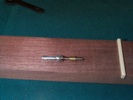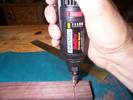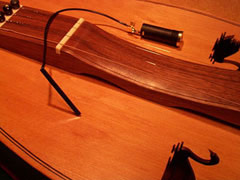The saddle slot must be cut deeper to accomodate the pickup.
The saddle slot for Bear Meadow instruments is .110" wide, and the depth is set to achieve the design action height. The pickup is .050" thick by .100" wide. Thus, this slot must be cut .050" deeper, with an exactly flat bottom. The Fishman pickup is extremely sensitive to the flatness of this slot's floor.
 The router bit supplied incorporates a design illustrated on YouTube by Robert O'Brien, of O'Brien Guitars. It essentially a section of #35 drill blank, ground to an angle at the business end. This tool will cut at the bottom, but not at the sides of a slot or wall. It is very useful for all sorts of jobs around the lutherie. The YouTube clip has many tips, and is recommended viewing for this job. To set the router bit up up for use, follow these steps:
The router bit supplied incorporates a design illustrated on YouTube by Robert O'Brien, of O'Brien Guitars. It essentially a section of #35 drill blank, ground to an angle at the business end. This tool will cut at the bottom, but not at the sides of a slot or wall. It is very useful for all sorts of jobs around the lutherie. The YouTube clip has many tips, and is recommended viewing for this job. To set the router bit up up for use, follow these steps:
- Mount the saddle upside down in its slot if necessary, so you can get a reliable reading of the action height with calipers. Make a note of the "action height" for later reference. Then read the total height of the saddle and subtract the action height to get the slot's depth. The pickup is .050" thick, so add that the the slot depth to get your depth of cut.
- An alternative method for measuring the slot depth is to draw a pencil line along the saddle as it sits in its slot. Carefully sharpen the pencil to a fine point by rubbing it on 400 grit sandpaper at a 45 degree angle. Then move the very tip of the pencil along the saddle at the juncture with the fretboard. Carefully measure from the bottom of the saddle just to the lower edge of your pencil mark.
- Adjust the depth of cut. The depth stop is a split ring of heavy wall brass tubing on the bit. The tubing has been crimped to give it a firm hold. If you find the hold is not firm (doesn't have to be real tight), take it off and crimp it gently with pliers. Remount, observing that the end toward the end of the bit is polished to avoid marring the finish.
- To insert the collet shim, remove the collet from its holder. Curl the shim around the butt of the router bit and feed the bit and shim gingerly into the collet, making sure the shim doesn't poke out between the collet slots.
- If the depth stop is too big to fit through the closing nut, remove the bit, leaving the shim in place. Insert the bit into the collet's closing nut and gingerly re-insert the bit into the collet, observing that the shim doesn't move out of location.
- Tighten the closing nut, gently pressing the depth stop to but against the closing nut's nose. Make sure that in further tightening of the nut, the depth stop stays butted against the nose of the closing nut. Recheck the depth stop for correct cutting depth.
 The cutter supplied is very forgiving of hand-held use, since its diameter exactly fits the existing saddle slot. Variations from vertical should not be exaggerated, though. Try to stay as vertical as possible. Also, since the cutter will follow any wall, cutting only when it engages material at the bottom of the cutter, there is no worry about marring finishes or deviating into cutting the slot wider. To cut the slot out deep enough to accomodate the pickup, follow these steps:
The cutter supplied is very forgiving of hand-held use, since its diameter exactly fits the existing saddle slot. Variations from vertical should not be exaggerated, though. Try to stay as vertical as possible. Also, since the cutter will follow any wall, cutting only when it engages material at the bottom of the cutter, there is no worry about marring finishes or deviating into cutting the slot wider. To cut the slot out deep enough to accomodate the pickup, follow these steps:
- With your small router or Dremel tool set at about 2000 rpm, rest the nose of the depth stop on the top of the fretboard, along its side, close to the slot.
- Slide gingerly along the side, remaining vertical, and around the corner into the slot, raising the tool so you are not cutting. Remember, the bit will not cut on walls! Nice!
- Now move along the slot, slowly lowering the tool until you are making a light cut.
- Continue along the whole slot length of the slot with a succession of light cuts until you feel the nose of the depth stop running on the top of the fretboard. Make each entry as in step 2.
- Remove the tool and power off. Clean all debris out of the slot and recheck depth by sliding the pickup into the slot, and the saddle on top of it. The height reading should match your original action height. If there is a deviation of of more than .004", consider resetting the tool and repeating. The intonation is somewhat sensitive to action height.
That's it! You're done cutting the saddle for the pickup.
The next task is to drill a 1/8" hole in the top directly below the  saddle slot on the bass side of the fretboard. Use a square needle file to widen this hole into a slightly elongated rectangle wide enough in both dimensions to readily accept the prepared pickup. Using the file, undercut the hole's fore and aft edges, to ease the entry of the pickup from below during insertion.
saddle slot on the bass side of the fretboard. Use a square needle file to widen this hole into a slightly elongated rectangle wide enough in both dimensions to readily accept the prepared pickup. Using the file, undercut the hole's fore and aft edges, to ease the entry of the pickup from below during insertion.
Lastly, the cowlings need to be cut to height. They are supplied long, so cut them off so they both rise just to the surface of the flat area of the fretboard where the saddle slot occurs. Position each one against the fretboard so that it is centered on the slot and, using a sharp pencil, mark down the sides fore and aft of the cowling to demarcate its mounting area. Be sure not to swap the cowlings' positions, as they aren't necessarily identical. Using a small sloyd-bladed knife, gently scrap through the wax and varnish inside the position markings to expose bare wood, for gluing later.
 Now we are ready for pickup insertion. We'll also glue on the cowlings, to make a good finish for the pickup ends and protect the pickup wire.
Now we are ready for pickup insertion. We'll also glue on the cowlings, to make a good finish for the pickup ends and protect the pickup wire.
Saddle Slot Prep

